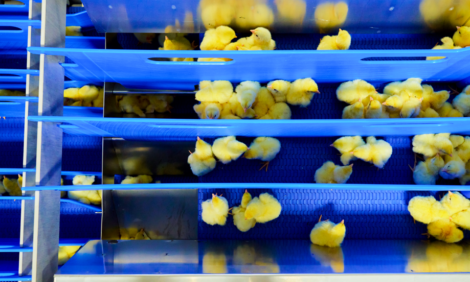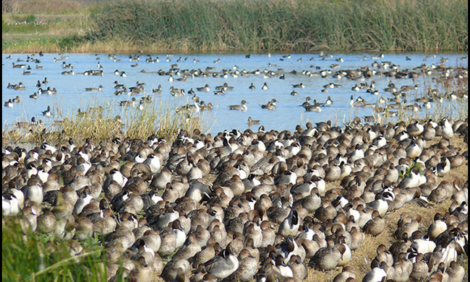



Global Overview for Avian Influenza
Since 2003, H5N1 bird flu has killed or forced the culling of more than 400 million domestic poultry and caused an estimated US$20 billion in economic damage across the globe before it was eliminated from most of the 63 countries infected at its peak in 2006, according to a report from the Food and Agriculture Organisation of the United Nations.The H5N1 HPAI virus remains endemic in six nations.
The number of outbreaks in domestic poultry and wild bird populations shrank steadily from 2003 to mid-2008.
The number of outbreaks rose progressively from mid-2008 to mid-2011 but has decreased since then.
During the reporting period, there were 164 domestic poultry outbreaks reported from 10 countries/territories (Bangladesh, Bhutan, China (including Hong Kong), Egypt, India, Indonesia, Israel, Myanmar, Nepal and Viet Nam), 22 confirmed reports of human cases in six countries (Bangladesh, Cambodia, China, Egypt, Indonesia and Viet Nam) and 18 confirmed wild bird events in China (Hong Kong), India and Nepal.
The period January to March is generally considered the peak of the H5N1 HPAI season, when outbreak numbers increase following an active period of disease events/reports (October to December).
Although there was a small increase in the number of outbreaks reported during the first quarter of 2012 compared to the last quarter of 2011 (153 to 182), the number of countries reporting remained the same.
In addition, the number of outbreaks recorded during this period represents a six-fold decrease in the number observed during the first quarter of 2011.
This reduction may be due in part to the lower reporting numbers from Egypt and Indonesia, as well as a lack of reports from countries where the disease has occurred sporadically like Japan and the Democratic People’s Republic of Korea.
Since 2003, 63 countries/territories have experienced outbreaks of H5N1 HPAI. The last newly infected country was Bhutan in February 2010.
Effective control measures for outbreaks in poultry have been associated with a reduced incidence of human infections in several countries. Even if the apparent decrease in outbreak numbers in poultry during the H5N1 HPAI active periods (January to March) for the last three years (2009 to 2012) has resulted in a reduced risk for human infections in affected countries, the fact that the number of countries reporting has remained constant during this period shows there is a continued risk although at a lower level.
The H5N1 virus has infected 602 people since it first appeared in 2003, killing 355 of them, according to WHO figures.
The latest countries with reported human deaths in March include Bangladesh, Viet Nam, Egypt and Indonesia. Given the continued reports of human infection, there is an need to identify the drivers or factors responsible for the H5N1 HPAI virus evolution in particular in endemic settings such as China, Viet Nam, Egypt and Indonesia.
Although H5N1 HPAI continues to be a global threat for poultry and humans, most countries rely on passive surveillance based on the reporting of clinical cases in poultry.
As a result, outbreak information is under-reported. Active surveillance in poultry and wild bird species therefore needs to be maintained by governments in endemic countries and countries at risk globally.
The confirmation of clade 2.3.2 in wild birds particularly crows in India and the first confirmation in poultry in Bhutan during this quarter provides some evidence that this virus is continuing to spread. Virus clade 2.3.2 may continue to expand its geographic range from South East Asia to other regions.
Worldwide Situation - Observed Trends
Over the three months January to March 2012, 164 H5N1 HPAI outbreaks in poultry were reported officially from the following countries: Bangladesh, Bhutan, China (including Hong Kong), Egypt, India, Indonesia, Israel, Myanmar, Nepal, and Viet Nam. Eighteen wild bird events were reported during the same period in China (Hong Kong), India and Nepal.
Analysis and interpretation of the HPAI data, as presented in this report, obtained through official reports is limited as the data on outbreaks in many endemic countries is incomplete.
A number of endemic countries are currently implementing active surveillance for H5N1 HPAI with assistance from FAO, the outputs of which are considered essential to understand the dynamics of H5N1 outbreaks in those endemic areas and consequent risks to poultry and humans. Reporting of sick poultry is masked in some countries using vaccination against H5N1 HPAI as part of disease control strategies (China, Viet Nam and Egypt) and with little information on the disease situation in the commercial poultry sector.
Since early 2011, a number of countries in Asia have experienced new virus introductions, particularly of virus clade 2.3.2.1, which in most cases wild birds were implicated.
These include India, the Republic of Korea, Japan, Myanmar and Nepal.
Bhutan has reported this clade for the first time during this reporting period in poultry.
Of those countries experiencing new virus introductions in 2011, Japan and the Republic of Korea have not reported outbreaks this quarter, having apparently eliminated the virus by applying stamping out policies.
Bangladesh, which experienced a new introduction of virus clade 2.3.2.1 in 2010, has had continued reports of outbreaks during all four quarters of 2011 and the first quarter of 2012, with apparent spill-over to poultry in India, as suggested by similarities in the genetic characteristics of viruses involved in both countries.
India reported three events in wild birds as well as six events in poultry during this period. Indonesia, Viet Nam and Egypt, where the disease is considered endemic, continued to report outbreaks in poultry with no new virus introductions.
Confirmation of clade 2.3.2 in Nepal during the last quarter of 2011, two years since the last outbreaks, implies continued risk for poultry in the South Asia region.
Clade 1.1 viruses, which evolved from Clade 1, continue to circulate in the lower Mekong.
Clade 2.1 variants, both in Indonesia and in new viruses introduced to Viet Nam, are now the dominant strains, replacing Clade 2.3.4.
Virus clade 2.3.2 in its various forms is now considered the dominant type in China, although Clade 2.3.4 has not disappeared.
However, the available information on virus clade distribution should be interpreted carefully, since this may not represent the true distribution of clades in poultry populations globally.
This is because affected countries only send a portion of positive samples to reference laboratories for clade identification.
Further ReadingYou can view the full report by clicking here. |
Further ReadingYou can visit the Avian Flu page by clicking here. |
July 2012









